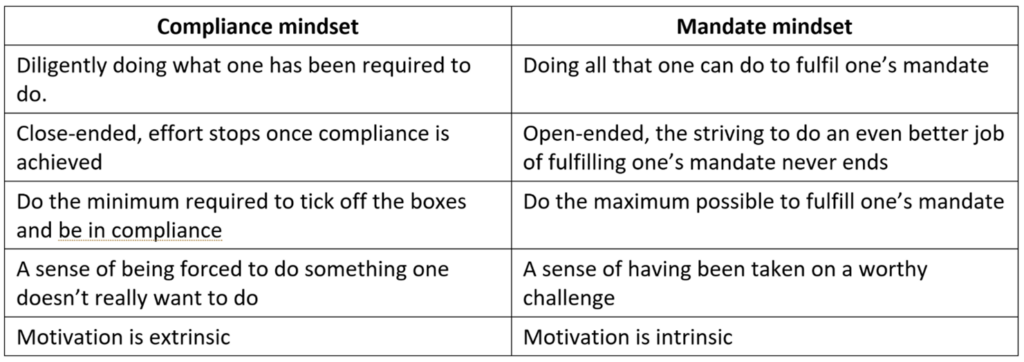For some, professional regulation is synonymous with administrative burden and extra costs. Regulation is what gets in the way of doing what one really wants to do. And yet, the HR profession chose to ask the Ontario Legislature to establish and empower a professional regulatory body that would govern and regulate its members, firms, and students.
In this blog, we explore the difference between a compliance mindset and mandate mindset and why the latter is important for advancing the HR profession and protecting the public interest.
The two mindsets
The word compliance is often used in the context of externally imposed rules. The word itself seems to bring to mind the idea of being forced to do things or being forced to do things in certain ways. Checklists are set out and boxes are ticked. Essentially, a compliance mindset looks at matters from a meet/does not meet basis.
But a compliance mindset also tends to encourage the stopping of any effort once the minimum is met. Sometimes, a compliance mindset can lead to a work-to-rule attitude. At its worst, a compliance mindset leads to resistance and even sabotage.
A mandate mindset stands in contrast to a compliance mindset.
A mandate mindset is driven from purpose. Fulfilling a purpose is not a matter of ticking boxes—it is an open-ended commitment to a purpose, cause, or objective. A mandate mindset is not about grudgingly meeting requirements but forwarding a cause. There are still rules, but these are experienced very differently.
There is a difference between compliance, which is the behaviour of complying with a rule, and compliance mindset, which is the attitude one brings to complying with rules. Compliance is good, a compliance mindset can be problematic — at least not in matters of professional regulation.
Here’s what the difference between the two mindsets looks like for HRPA
At the Association level, you can look at HRPA’s enabling legislation from a compliance mindset or a mandate mindset. For instance, asking the question ‘what does the Act require HRPA to do?’ possibly belies a compliance mindset. The mindset here is that the Act imposes on HRPA all sorts of burdens in the form of duties and requirements. Now the Act does require HRPA to do a number of things, but what it really does is give HRPA a mission and a mandate. This requires a mindset shift because ticking boxes is not the right mindset for the situation. What is required is a mandate mindset.
The mandate that has been given to HRPA by the Ontario Legislature is to promote and protect the public interest from the risks that can occur from the HR profession. Such risks include discrimination, loss of productivity, physically unsafe workplaces, toxic workplaces, harassment, bullying, violence, employee rights violations and many more. To do this, HRPA was mandated to govern and regulate the practice of its members, firms, and student registrants. From a mandate mindset the question is “have we done all we can to fulfill the mandate that has been given to us by the Ontario Legislature?”
Here’s what the difference between the two mindsets looks like for HR professionals
The difference between a compliance mindset and a mandate mindset also applies at the level of the individual practitioner. HRPA, in fulfilling its mandate as a professional regulatory body, will impose various requirements on its members, firms, and students. Some members may choose to see these obligations and requirements simply as burden’s to be complied with (or not). But that would be unfortunate. That’s because as HR professionals, we have voluntarily taken on a personal and collective mandate to practice our profession in a manner that is consistent with the public interest. This is also an open-ended mandate. It is a purpose, not a checklist.
The table below summarizes the differences between a compliance mindset and a mandate mindset. The table works at both the Association and the individual practitioner levels.

Visit Professional Regulation Demystified to learn more about the importance of professional regulation or check out our Professional Guidance resources.
